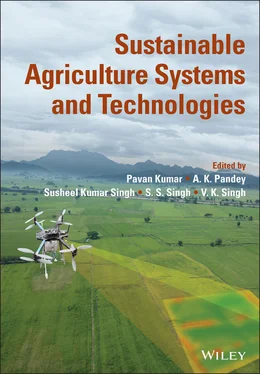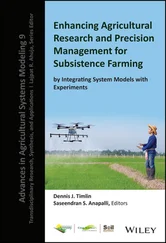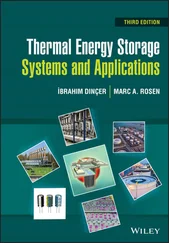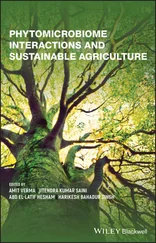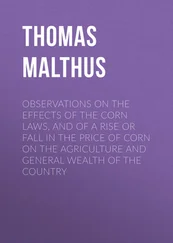Sustainable Agriculture Systems and Technologies
Здесь есть возможность читать онлайн «Sustainable Agriculture Systems and Technologies» — ознакомительный отрывок электронной книги совершенно бесплатно, а после прочтения отрывка купить полную версию. В некоторых случаях можно слушать аудио, скачать через торрент в формате fb2 и присутствует краткое содержание. Жанр: unrecognised, на английском языке. Описание произведения, (предисловие) а так же отзывы посетителей доступны на портале библиотеки ЛибКат.
- Название:Sustainable Agriculture Systems and Technologies
- Автор:
- Жанр:
- Год:неизвестен
- ISBN:нет данных
- Рейтинг книги:5 / 5. Голосов: 1
-
Избранное:Добавить в избранное
- Отзывы:
-
Ваша оценка:
- 100
- 1
- 2
- 3
- 4
- 5
Sustainable Agriculture Systems and Technologies: краткое содержание, описание и аннотация
Предлагаем к чтению аннотацию, описание, краткое содержание или предисловие (зависит от того, что написал сам автор книги «Sustainable Agriculture Systems and Technologies»). Если вы не нашли необходимую информацию о книге — напишите в комментариях, мы постараемся отыскать её.
A robust treatment of traditional and new techniques in sustainable agriculture Sustainable Agriculture Systems and Technologies,
Sustainable Agriculture Systems and Technologies
Sustainable Agriculture Systems and Technologies — читать онлайн ознакомительный отрывок
Ниже представлен текст книги, разбитый по страницам. Система сохранения места последней прочитанной страницы, позволяет с удобством читать онлайн бесплатно книгу «Sustainable Agriculture Systems and Technologies», без необходимости каждый раз заново искать на чём Вы остановились. Поставьте закладку, и сможете в любой момент перейти на страницу, на которой закончили чтение.
Интервал:
Закладка:
4.7 ICAR Initiatives
In the state of Uttar Pradesh, after a complete lockdown Phase 1: 25 March 2020–14 April 2020 (21 days) of 17 days, the total cases of COVID‐19 have risen above 500 with 35 deaths, although approximately 119 have recovered. Fortunately, this pandemic has not yet reached the stage of community spread (after stage 2: 15 April 2020–3 May 2020 [19 days]). Owing to complete lockdown, the daily wage earners, agricultural marketers, agricultural farmers, consumers, and related stakeholders are likely to suffer enormously. Therefore, the Government of Uttar Pradesh has issued two office orders permitting suppliers to continue the movement of honey, vegetables, mushrooms, fruits, milk, and related horticultural produce in the state. Secondly, permission to avail plant protection chemicals, seed fertilizers, agricultural commodities, and farm machineries has been granted. The effects of these efforts are apparent in the urban areas, as witnessed by the lack of panic in the purchase of fruits and vegetables in the cities. The ICAR has also issued advisories on specific farm practices applicable to this state, which have been circulated among farmers in every district by the KVKs.
4.8 Impact on State Agriculture
As the laborers from the nearby cities and Delhi have migrated to their respective villages, the availability of laborers for carrying out farm operations has increased. As a result, the daily wages at the village level have dropped by 15–20%. If available, their rates have increased by 30–40%. Due to reduced number of wholesalers in the mandis, the sale of vegetables has decreased, causing distress to the vegetable growers (Gaydon et al. 2017; Shyamsundar et al. 2019; Prasad 2020). However, the income of vegetable growers, and, in turn, the retailers has increased because of the higher prices quoted by them. The price of majority of the seasonal vegetables like cucurbits, brinjal, cabbage, potato, cauliflower, etc. has increased by 40–45%. Similarly, the fruit prices such as apple, grapes, banana, coconut, oranges, and many more have increased by 30–40%. Similarly, dairy farmers are experiencing the crisis of increased rates of feeds and concentrates (Gupta et al. 2020a,b). They need to sell milk at lower prices than the prevailing rates and even less quantities.
4.9 Conclusion
After lockdown, people below the poverty line are likely to overcome the impact slowly. However, farmers are expecting a recovery from the anticipated cash crash. A declaration of subvention for three to six months was previously assessed, while an initial step toward defeating the COVID‐19 has received an overwhelming response. However, currently, harvesters are expecting clarification on the following questions: what shall be the source of income for the farmers? and will the money come from own sources? What is the solution to mitigate the issue of migrated labor? These issues are not addressed in the present plan. An extension of the lockdown shall allow generation of more factors, allowing further predictions of its impact on the economy of the farmers.
The government of all countries should take strict and significant actions to keep up with the control of the virus. Socioeconomic decisions of the respective countries could significantly impact the final outcome and an alarming situation in the future could be predicted, because we have also considered these factors in our report. This study may assist the planners in India to take stringent actions to prevent further spread of the virus by developing timely strategies and effectuating their implementation based on the different levels of severities of COVID‐19 among the population of India presented here. It is highly desirable that other global regions take strict action to reduce exposure of their people for curtailing the spread of infection and provide timely support to facilitate the recovery of infected individuals.
References
1 Agricultural and Processed Food Products Export and Development Authority (APEDA) (2019). Basmati Survey ‐ Report‐1., Basmati Acreage & Yield Estimation in Punjab, Haryana, Delhi, Uttarakhand, Himachal Pradesh. Western Uttar Pradesh and Parts of Jammu & Kashmir, 52. New Delhi: Geotrans Technologies Pvt. Ltd., Basmati Export Development Foundation, APEDA.
2 Ceballos, F., Kannan, S., and Kramer, B. (2020). Impacts of a national lockdown on smallholder farmers' income and food security: empirical evidence from two states in India. World Dev. 136: 1050–1069.
3 Chaba, A.A. and Damodara, H. (2020). The Covid Nudge: Labour shortage makes Punjab, Haryana farmers switch from paddy to cotton. The Indian Express. https://indianexpress.com/article/india/covid‐19‐punjab‐haryana‐farmers‐paddy‐cotton6385600.
4 Chakrabarti, S., Khan, M.T., Kishore, A. et al. (2019). Risk of acute respiratory infection from crop burning in India: estimating disease burden and economic welfare from satellite and national health survey data for 250 000 persons. Int. J. Epidemiol. 48 (4): 1113–1124.
5 Chakraborty, D., Ladha, J.K., Rana, D.S. et al. (2017). A global analysis of alternative tillage and crop establishment practices for economically and environmentally efficient rice production. Nat. Sci. Rep. 7: 9342.
6 Chander, M. (2020). COVID‐19 crisis in India: How extension and advisory services can help. Agrilinks, Feed the Future, USAID. https://www.agrilinks.org/post/covid‐19‐crisis‐india‐how‐extension‐advisory‐services‐can‐help(accessed 5 May 2020).
7 Chander, S. and Mohan, B. (2020). Effect of planting date of rice on brown planthopper. Indian J. Entomol. 82 (2): 277–279.
8 Chatterjee, P., Nagi, N., Agarwal, A. et al. (2020). The 2019 novel coronavirus disease (COVID‐19) pandemic: a review of the current evidence. Indian J. Med. Res. https://doi.org/10.4103/ijmr.IJMR_519_20.
9 FAO (2020). Covid‐19 Pandemic: Impact on Food and Agriculture. Rome: Food and Agricultural Organisation http://www.fao.org/2019‐ncov/q‐and‐a/en.
10 Gaydon, D.S., Balwinder‐Singh, P.L., Poulton, H. et al. (2017). Evaluation of the APSIM model in cropping systems of Asia. Field Crop Res. 204: 52–75.
11 Gupta, S., Kishore, A., Alvi, M., and Singh, V. (2020a). Designing better input support programs: lessons from zinc subsidies in Andhra Pradesh, India. PLoS One 15 (12) https://doi.org/10.1371/journal.pone.0242161.
12 Gupta, N., Tomar, A., and Kumar, V. (2020b). The effect of COVID‐19 lockdown on the air environment in India. Glob. J. Environ. Sci. Manag. 6 (Special Issue (Covid‐19)): 31–40.
13 Jat, H.S., Sharma, P.C., Datta, A. et al. (2019). Re‐designing irrigated intensive cereal systems through bundling precision agronomic innovations for transitioning towards agricultural sustainability in north‐West India. Nat. Sci. Rep. 9: 17929.
14 Khan, T., Kishore, A., and Joshi, P.K. (2016). Gender Dimensions on Farmers' Preferences for Direct‐Seeded Rice with Drum Seeder in India. New Delhi: International Food Policy Research Institute.
15 Kumar, A., Padhee, A.K., and Kumar, S. (2020). How Indian agriculture should change after COVID‐19. Food Secur. 12 (4): 837–840.
16 Kumar, P., Singh, S.S., Pandey, A.K. et al. (2021). Multi‐level impacts of the COVID‐19 lockdown on agricultural systems in India: the case of Uttar Pradesh. Agric. Syst. 187: 103027.
17 Linton, N.M., Kobayashi, T., Yang, Y. et al. (2020). Incubation period and other epidemiological characteristics of 2019 novel coronavirus infections with right truncation: a statistical analysis of publicly available case data. J. Clin. Med. 9 (2): 538.
18 Lowe, M. and Roth, B. (2020). India's Supply Chain Unchained. New Delhi, India. http://southasia.ifpr: International Food Policy Research Institute (IFPRI), South Asia Office http://i.info/2020/06/18/indias‐supply‐chains‐unchained.
Читать дальшеИнтервал:
Закладка:
Похожие книги на «Sustainable Agriculture Systems and Technologies»
Представляем Вашему вниманию похожие книги на «Sustainable Agriculture Systems and Technologies» списком для выбора. Мы отобрали схожую по названию и смыслу литературу в надежде предоставить читателям больше вариантов отыскать новые, интересные, ещё непрочитанные произведения.
Обсуждение, отзывы о книге «Sustainable Agriculture Systems and Technologies» и просто собственные мнения читателей. Оставьте ваши комментарии, напишите, что Вы думаете о произведении, его смысле или главных героях. Укажите что конкретно понравилось, а что нет, и почему Вы так считаете.
